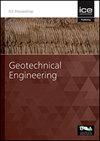Dynamic effective stress analysis of a centerline tailings dam affected by subduction earthquakes – Case Study
IF 1.7
4区 工程技术
Q3 ENGINEERING, GEOLOGICAL
Proceedings of the Institution of Civil Engineers-Geotechnical Engineering
Pub Date : 2022-02-16
DOI:10.1680/jgeen.21.00017a
引用次数: 2
Abstract
We present a case study that evaluates the seismic performance of a centerline tailings dam in the South American Andes through dynamic effective stress analyses with advanced constitutive models. The seismic demand at the dam site was evaluated through a probabilistic seismic hazard analysis (PSHA), which derived in deterministic and probabilistic-based seismic design criteria. The PSHA results were used to select spectrally matched ground motions for the subsequent dynamic analyses. The centerline tailings dam is planned to be raised in stages to 90 m high, which was considered in establishing the initial stresses and pore pressures before seismic loading. The material properties were based on a large geotechnical characterization program considering the mine tailings to be stored in the deposit and other critical dam components. The dynamic analyses were performed using the UBCHYST constitutive model for materials that are not expected to generate significant excess pore pressures and the PM4Silt constitutive model for the materials that may generate excess pore pressures due to cyclic loading. The results show the deformation patterns in the centerline dam, after the seismic loading, are significantly affected by the mine tailings presence. The results are useful to plan the overall operational management of the tailings facility.俯冲地震作用下中线尾矿坝动有效应力分析——以某尾矿坝为例
我们提出了一个案例研究,通过动态有效应力分析和先进的本构模型来评估南美洲安第斯山脉中心线尾矿坝的抗震性能。通过概率地震危险性分析(PSHA)对坝址的地震需求进行了评估,并推导出确定性和基于概率的地震设计准则。PSHA结果用于选择频谱匹配的地面运动,用于随后的动力学分析。在建立地震加载前的初始应力和孔隙压力时,考虑了中心线尾矿坝计划分阶段抬升至90 m高。材料的性质是基于一个大型岩土工程表征程序,考虑了储存在矿床中的矿山尾矿和其他关键的水坝组成部分。动态分析使用UBCHYST本构模型对不会产生显著超孔隙压力的材料进行分析,使用pm4淤泥本构模型对由于循环加载可能产生超孔隙压力的材料进行分析。结果表明:在地震荷载作用下,尾矿的存在对中心线坝体的变形规律有显著影响。研究结果可为尾矿设施的整体运行管理规划提供参考。
本文章由计算机程序翻译,如有差异,请以英文原文为准。
求助全文
约1分钟内获得全文
求助全文
来源期刊
CiteScore
4.40
自引率
4.50%
发文量
68
审稿时长
3 months
期刊介绍:
Geotechnical Engineering provides a forum for the publication of high quality, topical and relevant technical papers covering all aspects of geotechnical research, design, construction and performance. The journal aims to be of interest to those civil, structural or geotechnical engineering practitioners wishing to develop a greater understanding of the influence of geotechnics on the built environment.

 求助内容:
求助内容: 应助结果提醒方式:
应助结果提醒方式:


